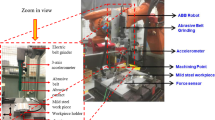Abstract
To improve the grinding process towards a higher surface integrity, in this study, an orthogonal test was designed and conducted to determine the effect of the wheel speed, workpiece speed, and the grinding depth on the surface integrity of a bearing raceway. After the grinding process, the residual stress, the residual austenite content, the surface hardness, the thickness of the affected layer, the surface roughness, and other properties were measured, and a parametric characterization of the surface integrity of the raceway was performed. Using the results of the orthogonal test as training samples, two support vector machine (SVM) models were established, and the prediction accuracy was tested through cross-validation. Finally, the step size search method was used starting at the optimal grinding parameters obtained through the orthogonal test, and the grinding parameters were further optimized using the two SVM models. The results showed that combining an orthogonal test with an SVM model can effectively shorten the time required for optimizing the grinding process, and that a global optimum can be obtained for the surface integrity.
Similar content being viewed by others
References
Davim JP (2010) Surface integrity in machining. Springer, London
Abrāo AM, Aspinwall DK (1996) The surface integrity of turned and ground hardened bearing steel. Wear 196(1):279–284
Zhejun Y, Zhonghui H, Kobayashi A (1989) Surface integrity of grinding of bearing steel GCr15 with CBN wheels. CIRP Annals-Manufacturing Technology 38(1):553–556
Donghui W (2001) The surface integrity of turned and ground hardened bearing steel with CBN grits and CBN tool [J]. Diamond & Abrasives Engineering 6:000
Vashista M, Gaddam A, Paul S (2012) Study of surface integrity of ground bearing steel using Barkhausen noise technique. Int J Adv Manuf Technol 63(5–8):771–783
Lee T, Ting T, Lin Y, Htay T (2007) A particle swarm approach for grinding process optimization analysis. Int J Adv Manuf Technol 33(11–12):1128–1135
Lee T, Ting T, Lin Y-J (2007) An investigation of grinding process optimization via evolutionary algorithms. In: 2007 IEEE Swarm Intelligence Symposium, IEEE, pp 176–181
Rao RV, Rai DP, Balic J (2016) Surface grinding process optimization using Jaya algorithm. In: Behera HS, Mohapatra DP (eds) Computational intelligence in data mining, vol 2. Springer, India, pp 487–495
Deng Z, Zhang X, Liu W, Cao H (2009) A hybrid model using genetic algorithm and neural network for process parameters optimization in NC camshaft grinding. Int J Adv Manuf Technol 45(9–10):859–866
Slowik A, Slowik J (2008) Multi-objective optimization of surface grinding process with the use of evolutionary algorithm with remembered Pareto set. Int J Adv Manuf Technol 37(7–8):657–669
Zhang G, Liu M, Li J, Ming W, Shao X, Huang Y (2014) Multi-objective optimization for surface grinding process using a hybrid particle swarm optimization algorithm. Int J Adv Manuf Technol 71(9–12):1861–1872
Hashimoto F, Lahoti G (2004) Optimization of set-up conditions for stability of the centerless grinding process. CIRP Annals-Manufacturing Technology 53(1):271–274
Inasaki I (1991) Monitoring and optimization of internal grinding process. CIRP Annals-Manufacturing Technology 40(1):359–362
Guo C, Campomanes M, McIntosh D, Becze C, Green T, Malkin S (2003) Optimization of continuous dress creep-feed form grinding process. CIRP Annals-Manufacturing Technology 52(1):259–262
Venk S, Govind R, Merchant ME (1990) An expert system approach to optimization of the centerless grinding process. CIRP Annals-Manufacturing Technology 39(1):489–492
Rao R, Pawar P (2010) Grinding process parameter optimization using non-traditional optimization algorithms. Proc Inst Mech Eng B J Eng Manuf 224(6):887–898
Rudrapati R, Pal PK, Bandyopadhyay A (2016) Modeling and optimization of machining parameters in cylindrical grinding process. Int J Adv Manuf Technol 82(9–12):2167–2182
Rascalha A, Brandão LC, Ribeiro Filho SLM (2013) Optimization of the dressing operation using load cells and the Taguchi method in the centerless grinding process. Int J Adv Manuf Technol 67(5–8):1103–1112
P-f YAN, Y-x WU, LIAO K (2010) Simulation and analysis of effect of cutting machining on residual stress distribution in thick aluminum alloy plate [J]. Journal of Central South University (Science and Technology) 6:029
Author information
Authors and Affiliations
Corresponding author
Rights and permissions
About this article
Cite this article
Chang, Z., Jia, Q., Yuan, X. et al. Optimization of the grinding process to improve the surface integrity of bearing raceways. Int J Adv Manuf Technol 91, 4243–4252 (2017). https://doi.org/10.1007/s00170-017-0061-3
Received:
Accepted:
Published:
Issue Date:
DOI: https://doi.org/10.1007/s00170-017-0061-3




